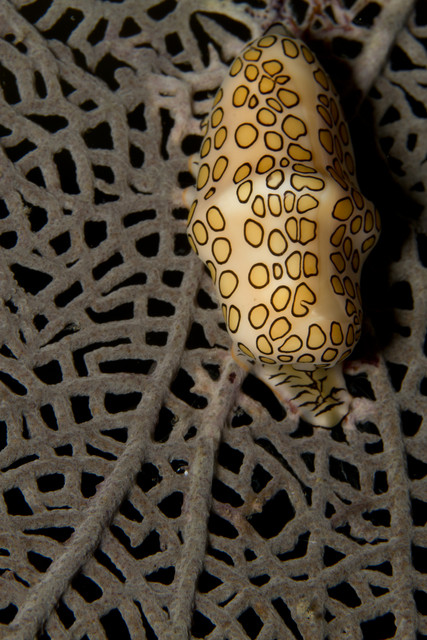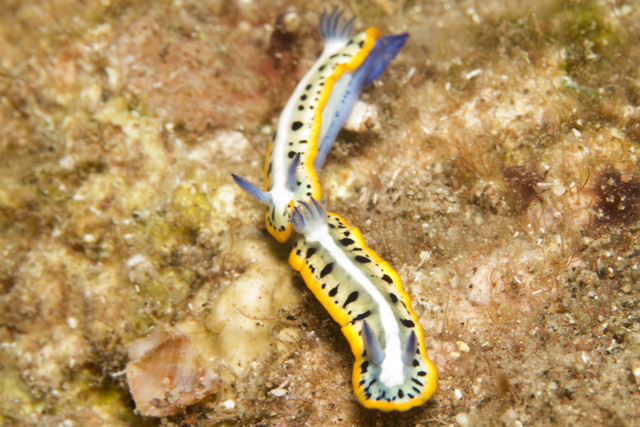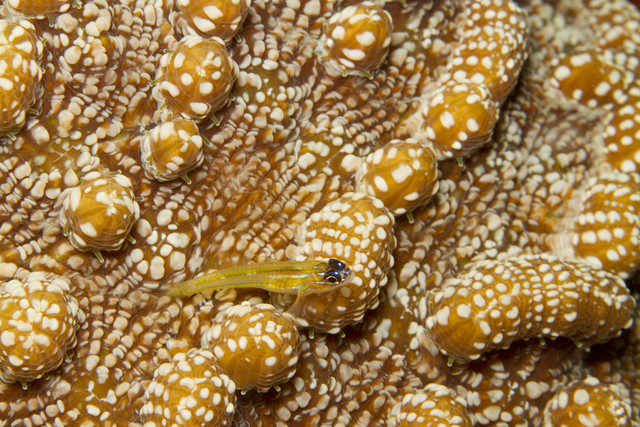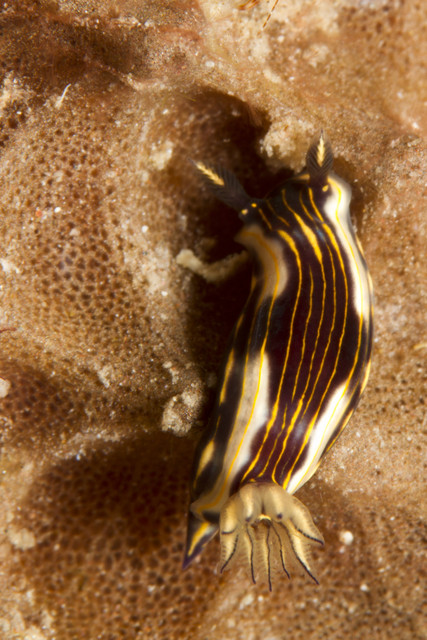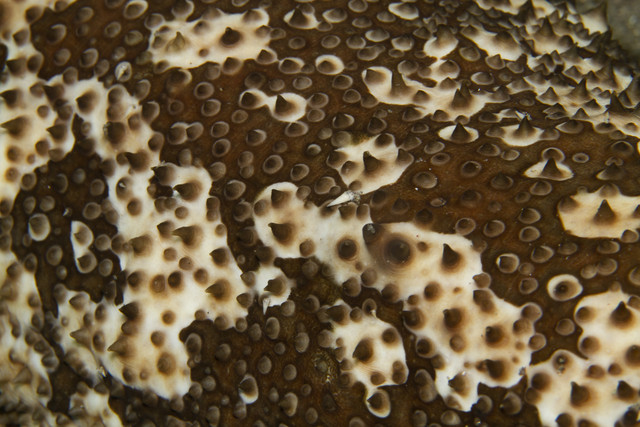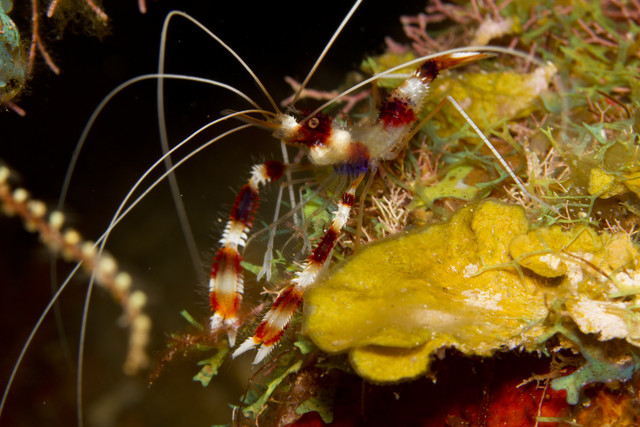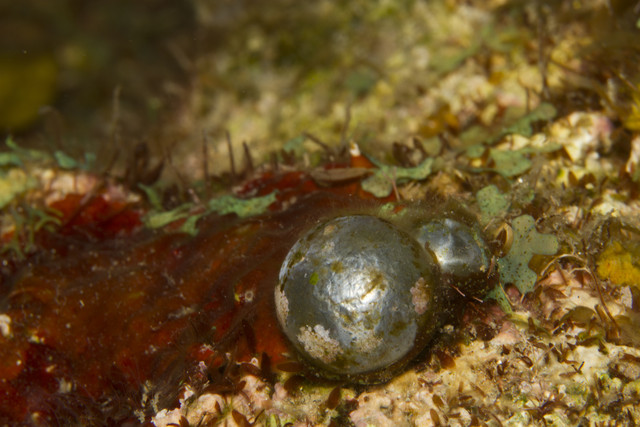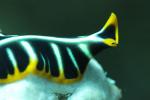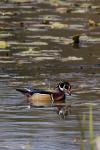underwater
Caribbean Explorer: Fireworm Assortment
ktuli — Sun, 02/05/2012 - 13:15
I'm getting anxious to get back in the water... I wouldn't even mind taking photos of more fireworms...
 |
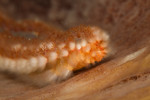 |
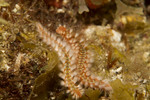 |

|
||
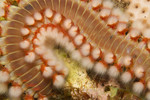 |
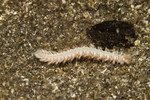 |
 |
Technical Data: Canon EOS 7D, Canon EF 100mm f/2.8L Macro IS USM, 1/120th sec at f/16. Image Stabilization on. ISO 100. Ikelite Housing and Port with Ikelite 161 Strobe in TTL Mode. Raw conversion in Photoshop CS5.
There you can even see a little of the variety of colors with the white and green ones...
- Bill
Caribbean Explorer: Flamingo Tongue
ktuli — Tue, 01/31/2012 - 20:11
Yes - this little snail is actually called a Flaming Tongue (Cyphoma gibbosum).
We saw plenty of these little snails on a lot of the dives on this trip, and while they certainly weren't moving much, they were difficult to photograph.
One challenge was because of their diet, which consists of the polyps of soft corals. The soft corals are often branching off in many directions (much like a small bush with no leaves) and thus getting a good angle to shoot through those branches was not always easy.
Exposure always seemed to be difficult too - here you can see I ended up with some weird shadows and a still somewhat darkened shot. I'm not sure if it was the soft corals or the mantles of the Flamingo Tongues that caused the problem, but I definitely struggled getting a good clean exposure.
Regardless, they certainly are interesting little critters. While they are snails, the colorful pattern you see is not the shell which is actually white (or off-white) with no pattern - it is actually the mantle of the snail wrapping up and over the top of the shell. It can be retracted back into the shell, and for whatever reason, Mike (our dive master) always seemed to find the retracted ones while we always found the regular ones.
Also visible in this shot is the damage these snails cause as they eat the polyps on the coral - leaving whitish scar tissue. The polyps do grow back, so the damage is not permanent.
Technical Data: Canon EOS 7D, Canon EF 100mm f/2.8L Macro IS USM, 1/120th sec at f/16. Image Stabilization on. ISO 200. Ikelite Housing and Port with Ikelite 161 Strobe in TTL Mode. Raw conversion in Photoshop CS5.
- Bill
Caribbean Explorer: Reef Camouflage
ktuli — Mon, 12/12/2011 - 22:04
Sometimes, you have to look twice to see a fish on the reef... sometimes you have to look twice to see the fish in the photo as well.
This little guy is a Saddled Blenny (Malacoctenus triangulatus), and that camouflage is absolutely perfect for hiding this small - about two inch - fish from predators on the reef.
Technical Data: Canon EOS 7D, Canon EF 100mm f/2.8L Macro IS USM, 1/120th sec at f/16. Image Stabilization on. ISO 200. Ikelite Housing and Port with Ikelite 161 Strobe in TTL Mode. Raw conversion in Photoshop CS5.
I know it isn't quite a "Where's Waldo?" photo, but it sure is close...
- Bill
Caribbean Explorer: More Purple-Crowned Sea Goddess Nudis
ktuli — Thu, 12/08/2011 - 20:38
I've been lazy recently - both with taking photos as well as posting photos. So, here's at least a new post here.
Technical Data: Canon EOS 7D, Canon EF 100mm f/2.8L Macro IS USM, 1/120th sec at f/16. Image Stabilization on. ISO 100. Ikelite Housing and Port with Ikelite 161 Strobe in TTL Mode. Raw conversion in Photoshop CS5.
- Bill
Caribbean Explorer: Patterns of the Reef (part 4)
ktuli — Wed, 11/30/2011 - 16:40
Another in my Patterns of the Reef series. Like the second in the series, this one also features a Peppermint Goby (Coryphopterus lipernes), but this time it is sitting on what I believe is some Knobby Cactus Coral (Mycetophyllia aliciae).
Technical Data: Canon EOS 7D, Canon EF 100mm f/2.8L Macro IS USM, 1/120th sec at f/16. Image Stabilization on. ISO 100. Ikelite Housing and Port with Ikelite 161 Strobe in TTL Mode. Raw conversion in Photoshop CS5.
Like I've said, these patterns are just everywhere on the reef.
- Bill
Caribbean Explorer: Gold-Lined Sea Goddess
ktuli — Sun, 11/27/2011 - 15:40
We didn't get to see as many different species of nudibranchs as we did in Wakatobi, so this is the last species I get to share from this most recent trip.
This is a Gold-Lined Sea Goddess (Hypselodoris ruthae). They are a very small nudibranch, only growing to about half an inch in size, and were only visible at night (yeah - when the sharks were bumping into us).
They aren't the flashiest of nudibranchs, but their small size certainly made them a fun one to find on the dives.
Technical Data: Canon EOS 7D, Canon EF 100mm f/2.8L Macro IS USM, 1/120th sec at f/16. Image Stabilization on. ISO 200. Ikelite Housing and Port with Ikelite 161 Strobe in TTL Mode. Raw conversion and cropped in Photoshop CS5.
If you happened to have missed them, go check out the Purple-Crowned Sea Goddess, Lettuce Sea Slug (and more), and Long-Horn Nudibranch.
- Bill
Caribbean Explorer: Patterns of the Reef (part 3)
ktuli — Wed, 11/16/2011 - 20:40
Another installment in my Patterns of the Reef series.
Technical Data: Canon EOS 7D, Canon EF 100mm f/2.8L Macro IS USM, 1/120th sec at f/16. Image Stabilization on. ISO 100. Ikelite Housing and Port with Ikelite 161 Strobe in TTL Mode. Raw conversion in Photoshop CS5.
The subject is a close-up of a Furry Sea Cucumber (Astichopus multifidus). I have no clue where they get the furry name, but whatever works...
- Bill
Caribbean Explorer: Another Banded Coral Shrimp
ktuli — Tue, 11/15/2011 - 19:03
I know I've already shared a shot of a Banded Coral Shrimp (Steopus hispidus), but I figured I'd share another since this one gives a bit better of an angle to see the details on the shrimp...
Technical Data: Canon EOS 7D, Canon EF 100mm f/2.8L Macro IS USM, 1/120th sec at f/16. Image Stabilization on. ISO 200. Ikelite Housing and Port with Ikelite 161 Strobe in TTL Mode. Raw conversion in Photoshop CS5.
- Bill
Caribbean Explorer: Smooth Trunkfish
ktuli — Sun, 11/13/2011 - 19:40
Ok - these little fish I have to share today are actually all juveniles (the one on the far right is a sub-adult) and range in size from about 1-2.5 inches (adults get to about 12 inches).
We called them Dice Fish, but they are Smooth Trunkfish (Lactophrys triqueter) in a post-larval stage.
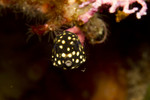 |
 |
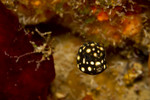 |
 |
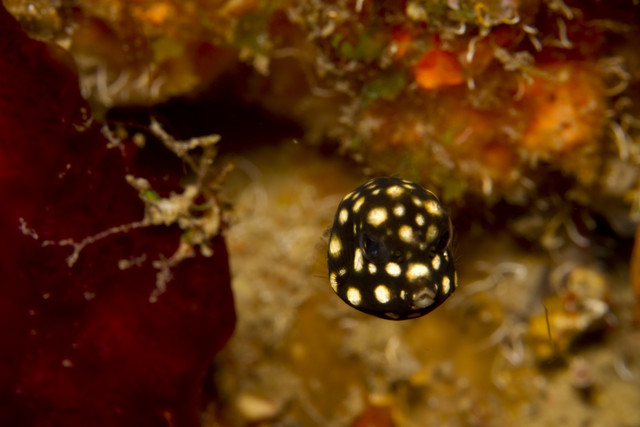 |
|||
Technical Data: Canon EOS 7D, Canon EF 100mm f/2.8L Macro IS USM, 1/120th sec at f/16. Image Stabilization on. ISO 100 or 200. Ikelite Housing and Port with Ikelite 161 Strobe in TTL Mode. Raw conversion in Photoshop CS5.
It should be pretty obvious why we called them Dice Fish. They are just fun to watch as they swim around - barely able to move with no real developed tail fin at this stage. They often just rotate in place.... and that funny little face - so funny!
- Bill
Caribbean Explorer: Sea Pearls
ktuli — Thu, 11/10/2011 - 19:10
We saw several Sea Pearls (Ventricaria ventricosa) when we were in Indonesia, and again on this trip in the Caribbean.
As it turns out, they are an algae (oddly enough, they are usually encrusted with a lavender crust algae). But what makes them interesting to me is the fact that they are a single cell organism. So those shimmering blobs of algae you see in the photo below are actually two individual cells! They can grow to over 2 inches in diameter, and the larger one here was probably in that size range. They are among the largest single celled organisms known.
Technical Data: Canon EOS 7D, Canon EF 100mm f/2.8L Macro IS USM, 1/120th sec at f/16. Image Stabilization on. ISO 100. Ikelite Housing and Port with Ikelite 161 Strobe in TTL Mode. Raw conversion in Photoshop CS5.
Learn something new every day...
- Bill

